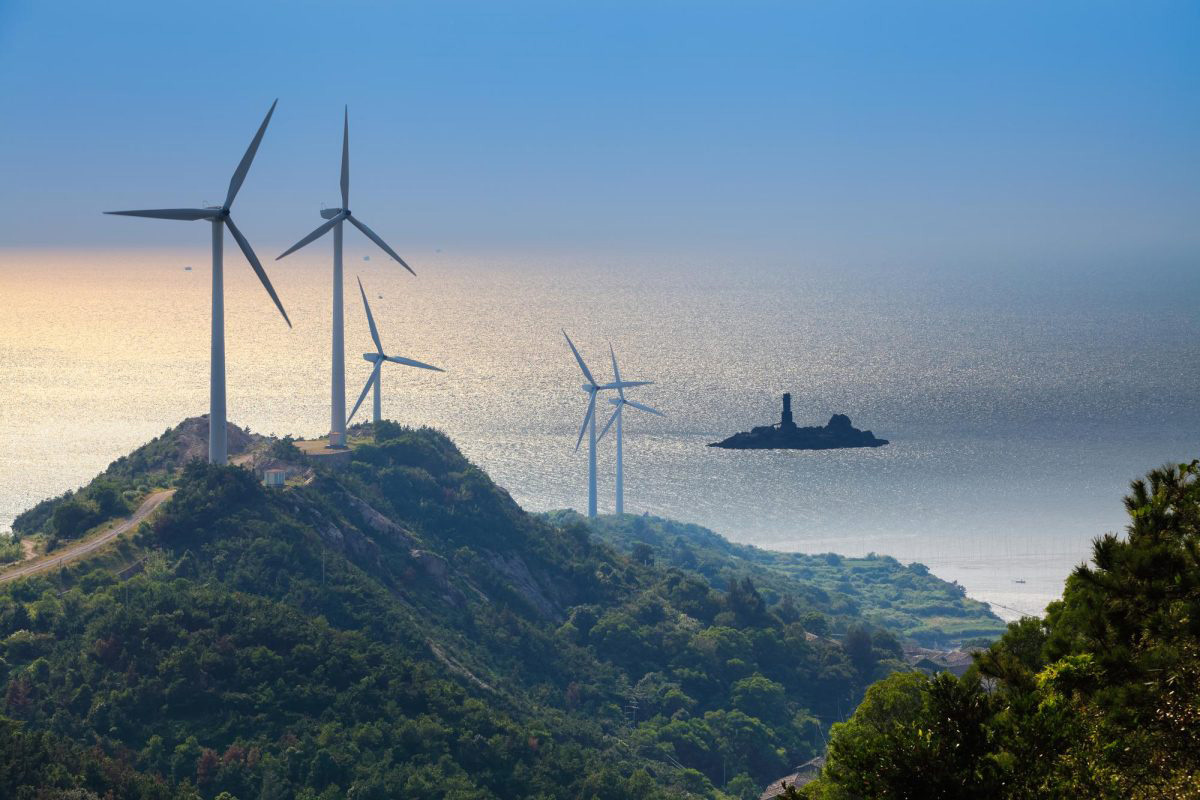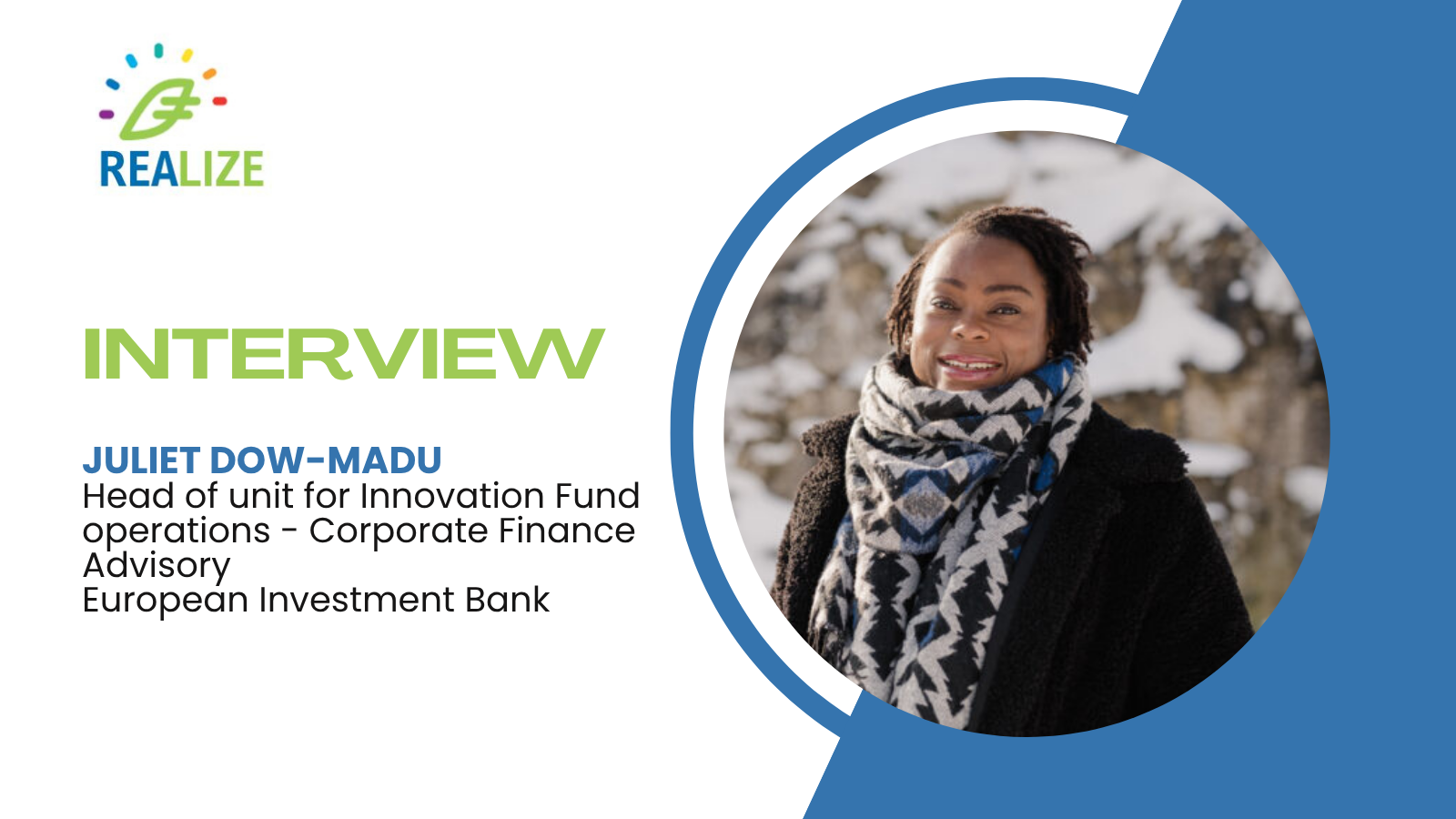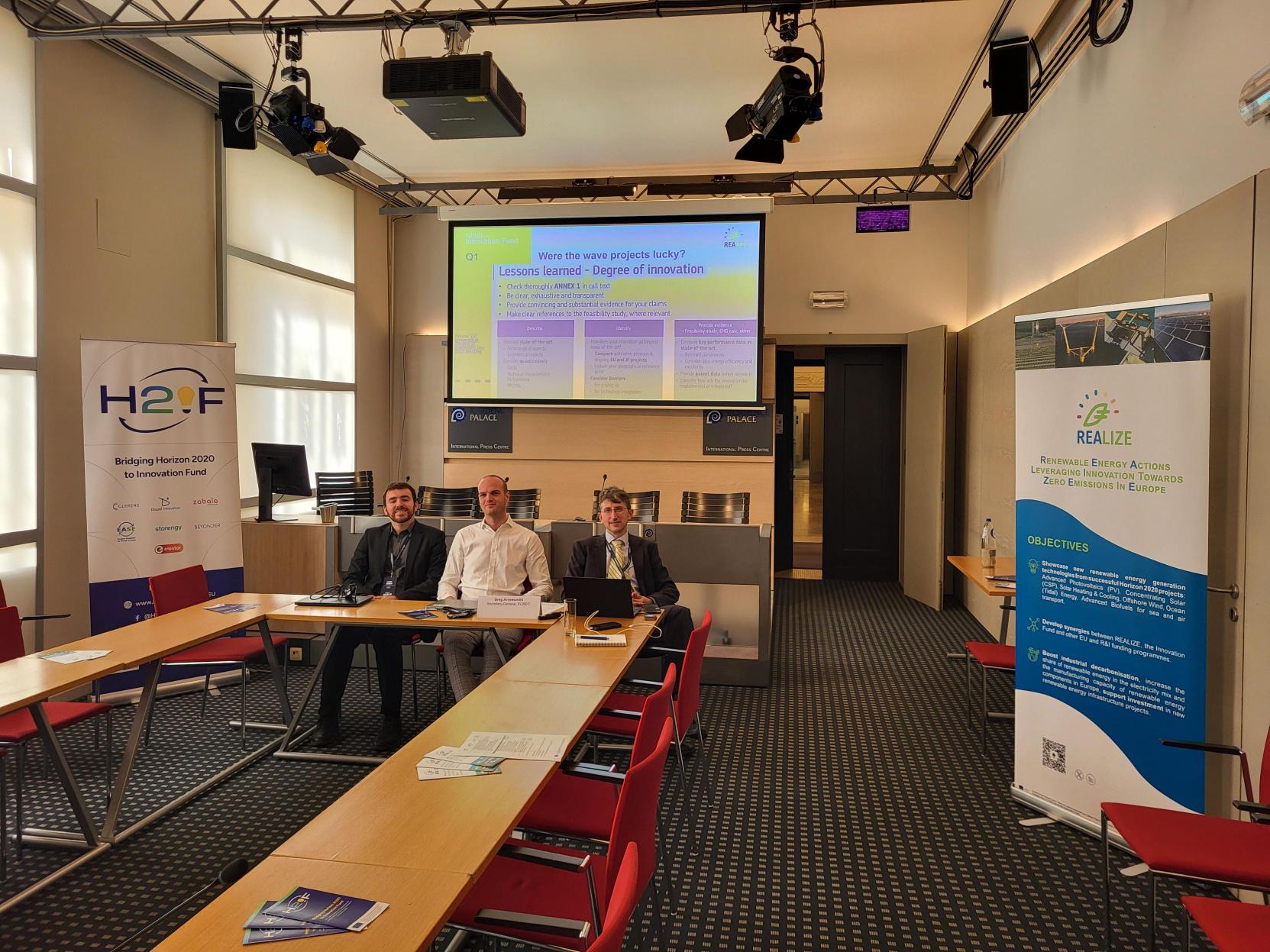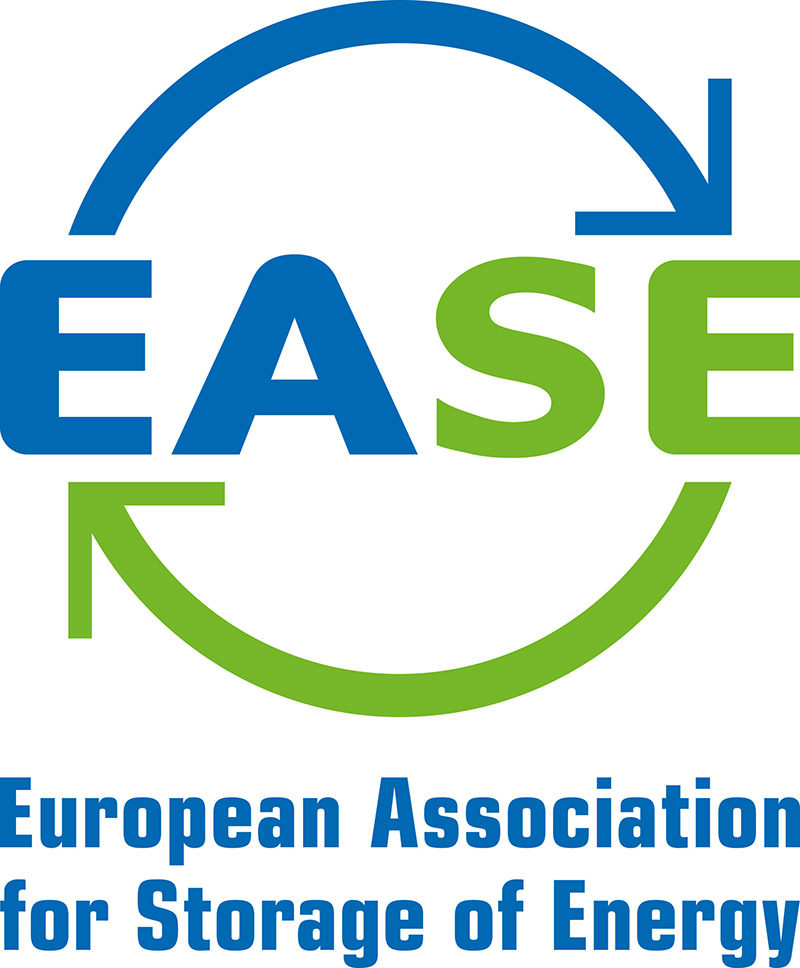REALIZE’s partner EUREC had the opportunity to interview Juliet Dow-Madu, Head of Unit for Innovation Fund operations at the European Investment Bank, to discuss the support of clean energy technologies and the funding instruments available to reach market deployment.
EUREC:The project promoters in REALIZE come from Horizon Europe and REALIZE is trying to get Innovation Fund funding. So there’s always this gap between low TRL and high TRL and making it to deployment. Could you talk a little bit about the gap the EIB and the Innovation Fund see between R&I and deployment?
Juliet Dow-Madu: I think the EIB recognises that there is a persistent gap between R&I and market deployment. It’s been there, particularly with these innovative technologies. The EIB has been trying to address it for some time by collaborating with the European Commission on developing thematic financing instruments. So not just those in the renewable side, but we were one of the early banks that got into renewables in the first place in the 90s I think. But we’ve also seen more so that this persistent gap has been there in the market with regards to, as I said, R&I and deployment.
And although there are high-quality R&I and research centres, the transition to commercialisation remains a bottleneck. We are aware of the scale-up challenges and have seen particularly that it’s quite common in the clean tech and deep tech sectors. Various market and economic studies done by the EIB over time, either for the Commission or for ourselves, have identified the bottlenecks. The high capital intensity and the needs and the long time to market, etc; the EIB tries to address this with the Commission through these thematic instruments. But the EIB cannot mop up all of the funding needs in the market. We do place ourselves as an institution that likes to crowd in other banks rather than crowd them out, and that’s because we’re here to support the markets, to lift them up.
Now, in terms of addressing this scale-up challenge, one of the more tailored financial instruments is the InvestEU programme, which was announced earlier this year as part of this Clean Industrial Deal, and that means bridging the gap by supporting disruptive, innovative projects and helping industrial scale-up of them. Now that will ideally create a platform for EIB lending to support scale-up in the EU and also will partner with the EIF on the equity side and ideally with other players in the market.
R&I is something that Europe is great at, but the industry needs more support to connect the two and not just create pilot projects, but actually pre-commercial and commercial projects, which unfortunately, other parts of the world are doing an amazing job at. So there’s a general feeling of the gap between research and deployment and the Innovation Fund tries to support that in its own way. On the EIB side, we have the Project Development Assistance, of course. Our team focuses on delivering the financial PDA to support Innovation Fund projects, and those who are eligible or interested in applying for other funding. For innovative first-of-a-kind disruptive technologies, we focus on helping them address the gaps in their financial proposals.
The Innovation Fund, as a grant team scheme, is trying to address this deployment matter. However, it still needs industry on the one hand, and on the other hand, it still needs financial markets to plug the holes, particularly for small-scale projects. Some small-scale promoters don’t have the means to fill in the funding gap, so we do try and look for commercial banks to step up and take more risk and ownership of these projects.
EUREC: When you’re talking about identifying bottlenecks, do you feel like it’s mainly funding? Obviously, the EIB can only lend so much and there are only so many funding sources out there, but do you see it’s mainly a funding issue or is there also the regulatory side?
Juliet Dow-Madu: The regulatory side affects perhaps some sectors more than others. For renewables, electricity generation and such, the regulatory markets I think, are quite favourable there. Even with hydrogen, the Commission and the Hydrogen Bank have tried to flex policy as much as possible to support it. So some sectors are favourable. I’m sure there are players in the market who would say no, there’s more that can be done. But I do feel that some sectors are quite well supported, particularly these hard-to-abate factors. I think there’s a lot of support there, whether through subsidies or favourable Power Purchase Agreements (PPAs).
And another one is building efficiency. The Commission can do one thing, but there is a point at which it falls to the Member States, too. I recall a project that we worked on a few years ago now, and it had to do with waste, like green disposal of insulation and building panels. It was a great project on paper, but the cost of taking the waste to the landfill just ate so much of it, it was such a big cost that the project needed a subsidy in that instance to support it. But that support wasn’t there from the Member State and wasn’t generally there on a European level. So those are some bottlenecks in terms of the actual technologies themselves, with the immaturity of the market, but the regulatory platforms can also be missing. The EIB’s job is not to overstep in terms of political suggestions and such, but sometimes we are asked to try and focus more on supporting certain sectors, and there’s only so much support you can give if the regulatory policies are not in place.
EUREC: You mentioned the Hydrogen Bank – I know in your presentation on PDAs that you mentioned trying to reach specific sectors. Do you think sector-specific or asset-specific instruments can be really helpful? Not only for funding but also simplifying the application reporting process. Do you think that’s a good way forward?
Juliet Dow-Madu: I do think so. For example, with the Innovation Fund started, it was very broad and could be large-scale or small-scale. Over time, the Commission has done a good job of trying to refine it and open very specific sectoral windows (for maritime, for energy-intensive industries). They’ve tried to compartmentalise so that it encourages promoters to be assessed against other projects in that specific sector, not just against the whole pool of applications of Innovation Fund. I think that’s quite complementary and that it hopefully gets to foster some more applications and submissions to the Innovation Fund to specific windows. The promoters in those sectors realise that there is interest and a possibility of quite significant EU funding. By having these dedicated windows, it helps to sort of put a spotlight on that specific sector.
EUREC: There’s a new Industrial Decarbonization Bank. It’d be interesting, especially for our partners, to know more about the kind of instrument design the EIB envisions for different purposes. So on the one hand, you’ve got the clean tech scale-up, supporting lower TRL . And on the other hand, obviously, we’ve got the heavy industry decarbonization that’s a main focus going forward, so how do you see the kind of balancing of the two?
Juliet Dow-Madu: We envision differentiated roles for these instruments. On one hand, the Innovation Fund focuses on a high-risk, high-impact clean tech scale-up, so the EIB supports this through the PDA, and then there’s our venture debt instrument, which is sort of quasi-equity and also the project finance and guarantees. There are quite a few options there in terms of instrumentation and support because it’s available to projects suitable for the Innovation Fund.
The Industrial Decarbonization Bank is still under development. It is expected to provide long-term concessional finance for heavy industry decarbonization with a focus on these hard-to-abate sectors (manufacturing and development plants). Unfortunately, they tend to emit sizeable volumes of greenhouse gas emissions. So if we are to make a scalable impact, one has to try and support those industries to decarbonise. And in fairness to them, we see a lot of projects through the Innovation Fund where these hard-to-abate sectors and these energy-intensive industries are trying. But in terms of this Industrial Decarbonization Bank, the intention is to crowd in private finance by de-risking these large-scale investments through guarantees of the commercial banks or guarantees of the project promoters, mainly in terms of corporate guarantees. Or it might be through guarantees of our financial institution partners.
EUREC: Could you comment on some of the common complementary funding options that get funding from your organisation, and how the presence of additional funding potentially influences your decision to award funding?
Juliet Dow-Madu: In terms of complementary funding, entities funded by the EIB can often combine support. We have a focus on lending, blending, and advising. The lending is, as you imagine, debt-equity. Advising is giving support to promote projects or advisory support that we provide to Member States or public sector entities in order to facilitate the development of projects. The blending is where we try and combine EIB support with EU support.
In terms of complementary funding, there are quite a few opportunities available. On one hand, you have the EU grants: we have Horizon Europe, Innovation Fund, and Modernisation Fund. There are also national regional subsidies and grants that are often easier to access because you start from the ground up, and then you have the private equity or venture capital that tends to look at favouring support from our venture debt or the EIF. EIF does not take direct equity, but invests in funds. However, in terms of EIB equity support, that would ordinarily be through our venture debt, which is a quasi-equity instrument. You can combine those with the EU funding, EU grants, national regional subsidies, and private equity venture capital to support the equity side and blend the finance together.
The presence of additional funding positively influences the EIB decision making, because it demonstrates both financial viability, because if people are interested in investing, they have done their due diligence, and it seems to be an economically viable and technically feasible project. So the presence of other parties, whether it be soft or hard money, suggests that the project demonstrates financial viability. The presence of additional funding is also positive in the sense that it provides risk sharing, which makes it easier for capital purposes and deployment of funding purposes. Additional funding shows that there’s interest in a project, but particularly on the equity side, it shows a broader stakeholder commitment, which is quite important, particularly for these innovative projects, because the EIB is essentially taking on market risk. For something that’s innovative, the market is not there yet. So we’re taking that market risk, with complementary funding, that helps us in terms of getting that broader picture. If there is stakeholder commitment, there is a chance for us to de-risk, and the project is financially viable.
EUREC: When it comes to the national regional funding you mentioned, I’ve seen a lot of projects with success work with the Just Transition Fund or the Recovery and Resilience Facility. And I know now the EU talks a lot about needing not just EU and public money, but also private financing. But I imagine that’s relatively rare for these innovative technologies, which haven’t really been proven and thus hold a lot more risk.
Juliet Dow-Madu: I did investment banking before I moved to the EIB and my focus mostly was leveraging structured finance and then project finance. So I’ve been in these origination desks where there have been great, interesting projects, but the capital demands are beyond a threshold that’s feasible for risk management teams in commercial banks. For commercial banks, their focus is shareholders, share price, and meeting risk requirements and such. And unfortunately, they don’t have the appetite to do as many decarbonisation and innovative projects.
EUREC: Since we’re talking about innovative technologies, I know the Commission is also really looking to simplify access to finance for SMEs and innovation. So what role does the EIB think that the bank and also implementing partners may have in kind of a more proactive outreach to strategic clean tech projects? How do you envision simplifying access to finance? I mean, this might be where the PDA comes in.
Juliet Dow-Madu: Yes, precisely. And even in a wider context, you know, we’ve had our EIB advisory hub, or advisory platform since 2016/2015. You can come through this channel and we can speak to promoters and identify which financing instruments might be most suitable or if they’re not quite ready for EIB purposes then we can try to support them with information on alternative access to finance rates, whether it’s potentially applying to the EIC (European Innovation Council), which is obviously much more relevant for smaller projects who have equity driven requirements. We look at alternative roadmaps to financing. If your project might be too early for EIB purposes, maybe we can direct it to regional or national programmes or EU programmes that could be suitable. That’s our main objective in terms of access to finance and that comes through our advisory services on our side.
In terms of outreach and where we are as a bank, events are something that we’re always doing across the bank. We set up these dedicated events where local offices will reach out through media, local newspapers and such, to advertise and promote such events in order to get eyes on it and to attract interested parties. We also, particularly in our advisory team (Advisory Growth Capital), focus on projects in the innovative realm, so all the venture debt products. And within our division, we also have dedicated workshops for a particular sector. Our InvestEU team has finance workshops where they have matchmaking sessions; they bring in promoters that have expressed interest in suitable projects, and then they matchmake by also bringing in partners from private equity venture capital or commercial banks and get everyone to talk. Could we do more? Always. But there’s a fixed amount of resources, so we have to try and balance and prioritise as much as possible with the resources we have.
EUREC: Now, if a project came, if they were looking to get EIB or Innovation Fund financing in some capacity, would you advise them to first go to the advisory hub platform or the Project Development Assistance?
Juliet Dow-Madu: It depends on the sector because the Innovation Fund focuses on clean tech/Net Zero technologies, so it’s not necessarily relevant for the deep tech or biotech technologies. If a project is focused on that realm of cleantech, I would suggest the first port of call is the Innovation Fund PDA. Now a project doesn’t have to necessarily want or need to apply to the Innovation Fund, it just needs to be eligible for it, because the Innovation Fund pays for the PDA through the ETF scheme. If it’s in that clean tech role, I would advise promoters to come and speak to us. We will assess and review the project from where the project started to where it is now or where it wants to go. And then we can identify what best fits. It could be the case for a project at a relatively early stage and it would then benefit from PDA. Or it could be at a mature stage and then we would quite happily introduce them to our colleagues in the lending team.
If a project is not quite ready for the Innovation Fund or not ready to talk about lending, then it can still be supported with advisory under our InvestEU advisory team, because the intention of the InvestEU advisory is that the promoter will be supported with relevant advisory service, whether financial modelling, capital structuring, business plan assessment, review, risk assessments, and so on. We ramp it up on a financial level and then pass the file over to our lending colleagues with a view to it entering our lending pipeline and ultimately hopefully being supported with the EIB lending.












